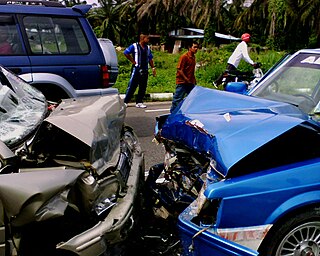
A seat belt is a vehicle safety device designed to secure the driver or a passenger of a vehicle against harmful movement that may result during a collision or a sudden stop. A seat belt reduces the likelihood of death or serious injury in a traffic collision by reducing the force of secondary impacts with interior strike hazards, by keeping occupants positioned correctly for maximum effectiveness of the airbag and by preventing occupants being ejected from the vehicle in a crash or if the vehicle rolls over.

Automotive safety is the study and practice of design, construction, equipment and regulation to minimize the occurrence and consequences of traffic collisions involving motor vehicles. Road traffic safety more broadly includes roadway design.

Road traffic safety refers to the methods and measures used to prevent road users from being killed or seriously injured. Typical road users include: pedestrians, cyclists, motorists, vehicle passengers, horse riders, and passengers of on-road public transport.

The ADAC is an automobile association in Germany, founded on May 24, 1903, as German Motorbiker Association, and given its present name in 1911.

Bicycle safety is the use of road traffic safety practices to reduce risk associated with cycling. Risk can be defined as the number of incidents occurring for a given amount of cycling. In many countries both the number of incidents and the amount of cycling are not well known. Non-fatal accidents often go unreported and bicycle use is only occasionally monitored. Some of this subject matter is hotly debated: for example, the discussions as to whether bicycle helmets or cyclepaths really improve safety. The merits of obeying the rules of the road including the use of bicycle lighting at night are less controversial.

A single-vehicle collision or single-vehicle accident is a type of road traffic collision in which only the one vehicle is involved. Included in this category are run-off-road collisions, collisions with fallen rocks or debris in the road, rollover crashes within the roadway, and collisions with animals.
The Royal Automobile Club of Spain (RACE), is a motor club/car club in Spain.
European Road Assessment Programme (EuroRAP) is an international nonprofit (vzw) organisation registered in Belgium. It operates from Worting House, Basingstoke, Hampshire.

The Polski Związek Motorowy is an automobile club and the governing body of motorsports in Poland. It is based in Warsaw.

Road slipperiness is a condition of low skid resistance due to insufficient road friction. It is a result of snow, ice, water, loose material and the texture of the road surface on the traction produced by the wheels of a vehicle.

Drainage gradient (DG) is a term in road design, defined as the combined slope due to road surface cross slope (CS) and longitudinal slope (hilliness). Although the term may not be used, the concept is also used in roof design and landscape architecture.
Road surface textures are deviations from a planar and smooth surface, affecting the vehicle/tyre interaction. Pavement texture is divided into: microtexture with wavelengths from 0 mm to 0.5 millimetres (0.020 in), macrotexture with wavelengths from 0.5 millimetres (0.020 in) to 50 millimetres (2.0 in) and megatexture with wavelengths from 50 millimetres (2.0 in) to 500 millimetres (20 in).
Vision Zero is a multi-national road traffic safety project that aims to achieve a highway system with no fatalities or serious injuries involving road traffic. It started in Sweden and was approved by their parliament in October 1997. A core principle of the vision is that 'Life and health can never be exchanged for other benefits within the society' rather than the more conventional comparison between costs and benefits, where a monetary value is placed on life and health, and then that value is used to decide how much money to spend on a road network towards the benefit of decreasing how much risk.
The Campaign for Safe Road Design is a partnership between 13 UK major road safety stakeholders that is calling for the UK Government to invest in a safe road infrastructure which in their view could cut deaths on British roads by 33%.

A traffic collision, also called a motor vehicle collision (MVC) among other terms, occurs when a vehicle collides with another vehicle, pedestrian, animal, road debris, or other stationary obstruction, such as a tree, pole or building. Traffic collisions often result in injury, death, and property damage.

The Road Safety Foundation is a United Kingdom charity which carries out and procures research into safe road design and road safety. The Foundation is responsible for the European Road Assessment Program (EuroRAP) in the UK and Ireland.
Worker road safety refers to the economic, societal, and legal ramifications of protecting workers from automobile-related injury, disability, and death. Road traffic crashes are a leading cause of occupational fatalities throughout the world, especially in developing countries. In addition to the suffering of the workers and their families, businesses and society also bear direct and indirect costs. These include increased insurance premiums, the threat of litigation, loss of an employee, and destruction of property.
Touring Club Belgium (TCB) is a motoring organisation providing roadside assistance, insurance, medical insurance and legal support throughout Belgium. TCB is a member of the FIA and ARCEurope.
Charles Adrian Hobbs is a safety expert in vehicle crashworthiness with a background in accident and injury investigation, and analysis.

Road Safety in Europe encompasses transportation safety among road users in Europe, including automobile accidents, pedestrian or cycling accidents, motor-coach accidents, and other incidents occurring within the European Union or within the European region of the World Health Organization. Road traffic safety refers to the methods and measures used to prevent road users from being killed or seriously injured.











